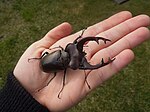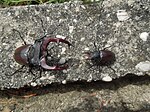Lucanus cervus
| Lucanus cervus | |
|---|---|

| |
| Male | |

| |
| Female | |
| Scientific classification | |
| Domain: | Eukaryota |
| Kingdom: | Animalia |
| Phylum: | Arthropoda |
| Class: | Insecta |
| Order: | Coleoptera |
| Family: | Lucanidae |
| Genus: | Lucanus |
| Species: | L. cervus
|
| Binomial name | |
| Lucanus cervus | |

| |
| Synonyms[2] | |
| |
Lucanus cervus, known as the European stag beetle, or the greater stag beetle, is one of the best-known species of stag beetle (family Lucanidae) in Western Europe, and is the eponymous example of the genus. L. cervus is listed as Near Threatened by the IUCN Red List.[1]
Taxonomy
Lucanus cervus is situated in the genus Lucanus within the family Lucanidae. In the genus there are two subgenera: Lucanus Scopoli, 1763 and Pseudolucanus Hope and Westwood, 1845.
Description

The European stag beetle is the largest beetle in Europe.[4] Their colour is usually black with reddish elytra (and red mandibles in males). Sexually dimorphic, the males have enlarged mandibles and are larger than the females. Although the male's mandibles seem threatening, they are too weak to be harmful. Nevertheless, females can inflict a painful bite. The resemblance of the male's mandibles to the antlers of a stag, and their use in combat between males, much like with deer, gives the species its scientific and common names.
Adult size varies between different areas of its distribution, for example beetles from Spain, Germany, and the Netherlands are larger than those from Belgium or the UK.[5] Males grow up to 7.5 cm (2.9 inches) in length, and females grow between 3 to 5 cm (1.1 to 1.9 inches).[6]
In Britain, female Lucanus cervus are often confused with both sexes of the lesser stag beetle (Dorcus parallelipipedus).[7][8][9] They can be distinguished as lesser stag beetles are smaller, with a completely black exoskeleton, and a larger, squarer head. Another difference is that Lucanus cervus larvae feed on wood below ground, and Dorcus parallelipipedus larvae eat wood above ground.[10]
-
Lucanus cervus female
-
Dorcus parallelipipedus male
-
Dorcus parallelipipedus female
Distribution and habitat
Lucanus cervus is widespread across Europe,
Lucanus cervus has been associated with a range of trees including those in the genera oak (Quercus), lime (Tilia), beech (Fagus), willow (Salix) and certain species in other genera including black poplar (Populus nigra), ash (Fraxinus excelsior), horse-chestnut (Aesculus hippocastanum), wild cherry (Prunus avium), and common walnut (Juglans regia).[17] Larval development sites were found in proximity of dead wood of the allochthonous Quercus rubra.[18]
Life cycle
Life cycle
Adults appear during late May to the beginning of August, being most active in the evenings. Females lay about 30 eggs in a piece of decaying wood deep in the soil. Stag beetle larvae, which are blind and shaped like a letter "C", feed on rotting wood in a variety of places, tree stumps, old trees and shrubs, rotting fence posts, compost heaps, and

The work of entomologist Charlie Morgan during the late 1970s discovered that the pupae of the stag beetle live in the soil for about 3 months, then emerge in summer to awkwardly fly off to mate.[
Lifespan
Stag beetles spend most of their life as larvae and can take from 3 to 7 years for them to pupate,[21] but the lifespan of the adults is only a few weeks.[22]
Subspecies
The species Lucanus cervus contains four subspecies, with Lucanus cervus cervus being the
-
Lucanus cervus cervus
-
Lucanus cervus judaicus
-
Lucanus cervus turcicus
-
Lucanus cervus akbesianus
-
Lucanus cervus laticornis (middle)
Behaviour and ecology
The natural reaction of the beetle to an approaching large object is to remain motionless, making them a good photographic subject.[citation needed]
Daily activity, use of space and detectability
In a primary ancient forest in northern Italy, stag beetle males were less elusive than females. Males were more frequently radio-tracked in flight, females mostly underground and in the proximity of deadwood. Males were mostly observed flying at sunset, and resting or walking on standing trees during the day. The combination of air temperature and humidity determined the optimal weather conditions for male flights. Flying at sunset, mostly performed by males, significantly increased the detectability of the species. [23] Stag beetles are shown to be more active during the first part of their adult lives. Males were more prone to disperse than females but the home range size did not differ between the sexes. Dividing the flight season in three intervals, the most active individuals were recorded during the first and the second ones (first and second half of June).[24]
Predators
Natural predators of L. cervus in Britain include
In Italy, the main predator is the hooded crow (Corvus cornix).[26]
Parasites
Mites in the order
Relationship with humans

Protection
Lucanus cervus is listed as Near Threatened by the IUCN Red List.[1] Although this species is widely distributed in Europe, it is in significant decline in the north and central part of its range and future trends of European forests will pose serious threats to this species, thus making the species close to qualifying for Vulnerable.[1]
Lucanus cervus is registered in the second appendix of the
Log pyramids
Log pyramids, also called stumperies, are vertical log piles where the logs are buries upright, providing plenty of underground rotten broadleaf wood for stag beetle larvae to feed on, as their natural food sources are in decline.[28]
Gallery
-
Size variation of males
-
Underside
-
Mouthparts – the galea (feathery) and the labial palps
-
Flying
-
Mating
-
Egg
-
Pupa
-
Video of males fighting
References
- ^ a b c d e f g h "Lucanus cervus". IUCN Red List of Threatened Species. 2017. 2017. Retrieved 2017-01-23.
- ^ a b "Stag Beetle, Lucanus cervus (Linnaeus, 1758)". BioLib.cz. Retrieved 2017-07-05.
- ^ "Genus. Lucanus Scopoli, 1763". BioLib.cz. Retrieved 2017-07-05.
- ^ "Stag beetles: facts about the UK's largest beetle and where to see it". www.nhm.ac.uk. Retrieved 2024-04-11.
- ^ .
- ^ Trust, Woodland. "Stag Beetle (Lucanus cervus) - British Beetles". Woodland Trust. Retrieved 2024-04-06.
- ^ Zoomology (2017-08-14). "On the Road: Stag Beetles (Lucanus cervus)". ZOOMOLOGY BLOG. Retrieved 2024-04-09.
- ^ "Similar species – European Stag Beetle Monitoring Network". Retrieved 2024-04-09.
- ^ "Stag beetles: facts about the UK's largest beetle and where to see it". www.nhm.ac.uk. Retrieved 2024-04-09.
- ^ "Lesser stag beetles facts". People's Trust for Endangered Species. Retrieved 2024-04-11.
- ^ Bartolozzi L.; Maggini L. (2006). "Insecta Coleoptera Lucanidae". In S. Ruffo; F. Stoch (eds.). Checklist and distribution of the Italian fauna. Museo Civico di Storia Naturale di Verona. pp. 191–192.
- ^ López-Colón, J. I. (2000). "Familia Lucanidae". In Martín-Piera, F.; López-Colón, J. I. (eds.). Fauna Iberica Vol. 14: Coleoptera, Scarabaeoidea I. CSIC.
- ^ Grosso-Silva, J.M. (1999). "Contribuição para o conhecimento dos lucanídeos (Coleoptera, Lucanidae) de Portugal". Boletín de la Sociedad Entomológica Aragonesa (in Portuguese). 25: 11–15.
- ^ "Lucanus cervus (Linnaeus, 1758) [Stag Beetle]". National Biodiversity Network. Retrieved 2017-02-24.
- ^ a b "About stag beetles". People's Trust for Endangered Species. 2017. Retrieved 2017-02-24.
- ^ "Eghjort". Ministry of Environment (Denmark). Retrieved 8 August 2023.
- ^ "Coleoptera >> Lucanidae >> Lucanus cervus (L.)". Database of Insects and their Food Plants (Biological Records Centre). Retrieved 2017-02-24.
- .
- ^ Encyclopedia of life. Retrieved 2017-02-24.
- ^ "Stag beetles: facts about the UK's largest beetle and where to see it". www.nhm.ac.uk. Retrieved 2024-04-06.
- ^ "Stag beetle facts". People's Trust for Endangered Species. Retrieved 2024-04-06.
- ^ "Stag beetles: facts about the UK's largest beetle and where to see it". www.nhm.ac.uk. Retrieved 2024-04-06.
- .
- hdl:11573/1070456.
- ^ Fremlin, m; Davidson, J.; Davidson, G. (2012). "Stag Beetle Predation by Magpies in a Colchester Garden" (PDF). Nature in North-East Essex: 81–85.
- .
- ^ Hawes, C. (2010). "Hitchhiking a lift: Stag Beetles as Carriers of Mites" (PDF). White Admiral. 77: 16–17.
- ^ "How to build a log pile". Stag Beetles. Retrieved 2024-04-10.
External links
 Media related to Lucanus cervus at Wikimedia Commons
Media related to Lucanus cervus at Wikimedia Commons Data related to Lucanus cervus at Wikispecies
Data related to Lucanus cervus at Wikispecies- stagbeetle.info Research site ran by Royal Holloway, University of London
- Biology of the Stag Beetle, translated from the Spanish article "de lo poco conocido y lo mucho por conocer"
- Brief illustrated look at the stag beetle
- 3D model of Lucanus cervus
- LIFE Rosalia: Lucanus cervus


















